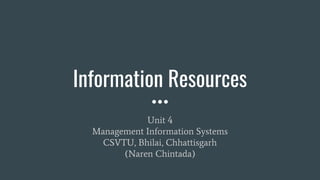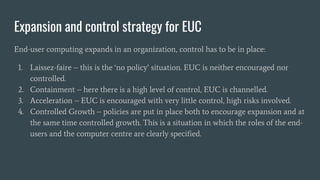This document discusses key information resources including data, application software, technology, information specialists, users, and facilities. It describes the role of the Chief Information Officer (CIO) in managing information resources, their responsibilities, priorities, and required competencies. The document also covers strategic planning for information systems, aligning IS strategy with organizational strategy, and issues around end-user computing.










![Strategic thrust table
The table is an example of how an organizations can analyse. By asking following
questions, an organization fill the boxes to build the strategy appropriate for them.
1. What are our strategic targets ? [ Customers, Suppliers, Competitor]
2. What strategic thrust can be used against the targets ? [5 rows shown in table]
3. What strategic mode can be used ? Offensive or defensive
4. What direction of thrust can be used ? [Usage or Provision]
5. What skills can we use ? [processing, storage, transmission]](https://image.slidesharecdn.com/informationresourcesmiscsvtu-201017165220/85/Information-resources-mis-csvtu-11-320.jpg)









